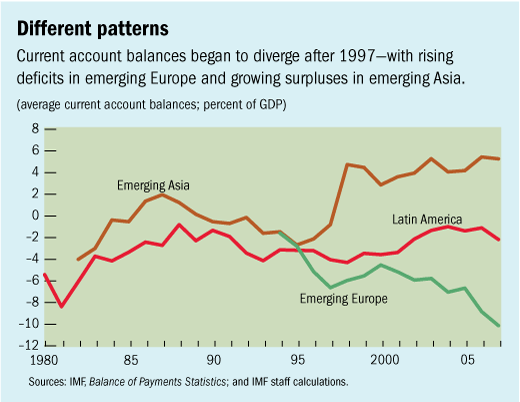
Typical street scene in Santa Ana, El Salvador. (Photo: iStock)
IMF Survey: Lessons From Cross-Regional Analysis
October 2, 2008
- Emerging Asia's current account surpluses up, emerging Europe's deficits deeper
- Varied degrees of financial liberalization explain many regional differences
- Persistent current account deficits in emerging Europe pose risks
A new IMF study explores the patterns of current account balances of emerging economies—especially in Asia and Europe—and asks why they have become much more diverse in recent years and what those differences mean for external vulnerability.

Store in Kuala Lumpur, Malaysia--one of few Asian countries whose big current account surpluses have not fallen (photo: Bazuki Muhammad/Reuters)
CURRENT ACCOUNTS IN EMERGING ECONOMIES
In emerging Asia, current accounts—the most important part of which is balance of trade—averaged a surplus of about 5 percent of GDP in 2007, while in emerging Europe current accounts reached on average a deficit of 10 percent of GDP in 2007 (see chart).
Different intraregional patterns
The shift to sizable deficits was quite uniform in emerging Europe, but there were large differences within Asia—with some persistent large surpluses and a few substantial deficits, according to the study published in an analytic chapter of the October 2008 World Economic Outlook. The chapter is entitled "Divergence of Current Account Balances across Emerging Economies."

Also, different countries in emerging Asia contributed at different times to the region's aggregate surplus. At the time of the Asian crisis, in 1997-98, the so-called crisis countries—mostly Korea and the "Asian Tigers" (Indonesia, Malaysia, the Philippines, and Thailand)—accumulated large current account surpluses, following the loss of access to international capital flows and in an effort to rebuild reserves. More recently, many of these surpluses have fallen, with the exception of Malaysia, while China started accumulating large current account surpluses.
Current accounts and growth
The divergent current account patterns have revived the long-standing debate on the connection between economic development and capital flows. Virtually all of these emerging economies have achieved high growth during the past decade, with very different current account positions.
Theory predicts that growth should lead to current account deficits for two reasons. First, high growth and the resulting profitable investment opportunities should make the country attractive to foreign capital. Second, if individuals want to smooth their consumption over time, prospects of continued high growth should lead to higher consumption today because income and consumption can be expected to rise further in the future.
The traditional view that capital flows downhill to high-growth countries seems to hold for emerging Europe, whereas capital has not flown in net terms to emerging Asia after 1997-98.
Determinants of current accounts
Our analysis shows that much of the regional differences can be explained by structural factors, including the traditional view that high growth prospects attract foreign capital and lower the current account balance.
In emerging Europe, the large current account deficits are related to the rapid liberalization of the domestic financial markets and capital accounts, which attracted large capital inflows and prompted a rapid rise of foreign bank ownership. The EU integration process has also boosted foreign capital inflows by improving prospects for economic and policy stability.
In contrast, in emerging Asia, the impact of high growth prospects on attracting inflows was outweighed by factors such as the more limited openness of the capital accounts and financial sectors, demographics (younger populations), and differences in the political structure.
But this is only part of the story, because a large fraction of the surpluses in emerging Asia remains unexplained. After ruling out a number of alternative hypotheses, one remaining explanation is the undervaluation of exchange rates in several Asian economies. We find some evidence in support of this claim.
But it is difficult to establish definitively whether the low exchange rate levels reflected deliberate policy action—for example, an export-led growth strategy or an attempt to build high levels of international reserves after the Asian crisis—or other unidentified factors that moved the current accounts into surplus after 1997. Such factors, however, are not easy to identify.
Risks from deficits and surpluses
The deficits in emerging Europe have lasted longer than has been typical historically for emerging economies, and most of these deficit episodes are still ongoing. This longer duration can partly be explained by economic fundamentals, such as the favorable initial level of their net foreign asset positions, strong growth prospects, and relatively open capital accounts. However, based on model estimates using other emerging economies' experiences, it appears that many of the current account deficit episodes in emerging Europe are now at or beyond the upper end of their expected duration.
While some reassurance can be gained from the fact that the large deficits in emerging Europe have reflected growth opportunities created by integration in the European Union, the possibility of serious short-term strains cannot be ruled out. The study identifies several risk factors for abrupt endings of capital inflows and thus current accounts. These include fixed exchange rate regimes and open capital accounts, which are characteristics of several of these countries.
While there may be many factors that motivate the choice of a fixed exchange rate regime and in particular the desire to enter the euro area, the countries that make this choice also need to protect themselves against external vulnerabilities. In this context, it is important to ensure that product and labor markets are flexible, that strong financial regulatory and supervisory frameworks are in place, and that macroeconomic policies are consistent with domestic and external balance.
Although surpluses seem safer from an external vulnerability perspective, they also bear risks. Among other things they can lead to a misallocation of capital impairing longer term growth prospects. Policies to prevent this include allowing exchange rates to adjust and a rebalancing of aggregate demand.
Comments on this article should be sent to imfsurvey@imf.org







